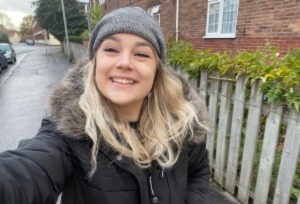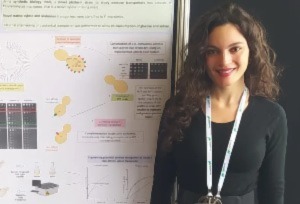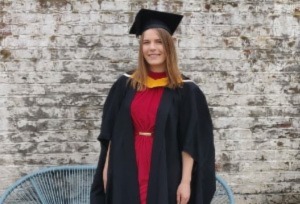Most Promising Science Poster Prize 2022: Microbiology
Posted on July 22, 2022 by Microbiology Society
Throughout Annual Conference 2022, delegates showcased excellent posters and exciting research. The Microbiology Society Journals ‘Most Promising Science’ prizes were awarded by Microbiology Editors. In this blog, we meet the winners to find out more about them and their research.
Emma Holden: 'Disruption of efflux activity reduces biofilm formation through multiple pathways'

Who or what inspired you to be a scientist?
I had always enjoyed science at school, but I think what pushed me to do science at university was the amazing teaching and support from my high school science teacher Mr Dave Hoover.
What are you currently working on and what area of your research excites you the most?
I’m currently using a high throughput whole genome screen called TraDIS-Xpress to determine how bacteria survive under stress. I used this, focusing on antimicrobial mechanisms of action and resistance.
How would you explain your poster to a child under 10?
Germs use little pumps to stop the medicine we use from killing them. When we take these pumps away, the germs stop being able to live in groups. When germs can’t live in groups, they’re easier to kill with medicine. My work explores the different ways this happens.
What would you be doing in your career if you weren’t a scientist?
If it wasn’t science, it would have been something similar. I probably would have become a paramedic, using the same troubleshooting and biology skills in a completely different way.
Lorena Donzella: 'Engineering a native Kluyveromyces marxianus transporter to reprogramme the balance between hexose and pentose transport'

Who or what inspired you to be a scientist?
I am from a small city in the South of Italy, Taranto. Environmental problems have dramatically affected my city so, since I was a child, I felt I had to do something to overcome these issues helping the environment. I realized that studying biotechnology was the key to do that.
What are you currently working on and what area of your research excites you the most?
I am designing yeast cell factories in order to completely use sugars deriving from agricultural waste named lignocellulosic biomass. I really like the challenges of lab work and it excites me thinking that the results I am getting can land up in industry, helping converting refineries in biorefineries.
How would you explain your poster to a child under 10?
In order to reduce pollution and environmental problems, we can use microorganisms that eat wastes and convert them into eco-friendly compounds. In my work, I study and create new yeasts, the microorganisms used to make bread, to completely eat up different kind of wastes, even though it’s not their favourite meal!
What would you be doing in your career if you weren’t a scientist?
In my free time, I relax cooking, mixing ingredients to create new recipes, sometimes they are amazing and some other are a disaster (not so different from lab life!). Maybe if I hadn’t become a scientist, I would be a cook now.
Eliza Rayner: 'Testing the sit-and-wait hypothesis for the evolution of virulence in Streptococcus suis'
Who or what inspired you to be a scientist?
I developed a passion for science thanks to the enthusiasm and support of many amazing teachers at my secondary school. I was first inspired to consider scientific research as a career because I really enjoyed lessons about science and the history of medicine when studying for my GCSEs.
What are you currently working on and what area of your research excites you the most?
I'm hoping to investigate whether there are any differences in the niches inhabited by commensal and pathogenic S. suis within pig tonsils. I find it exciting to empirically test evolutionary hypotheses about why pathogens have evolved to cause disease, because I find it such a fascinating open question.
How would you explain your poster to a child under 10?
Streptococcus suis is a germ that lives in pigs, where it mostly does them no harm. A new type of Streptococcus suis makes both pigs and humans unwell. We found that this type can live longer on surfaces outside pigs, showing the importance of cleaning farms and cooking pork well.
What would you be doing in your career if you weren’t a scientist?
Probably something creative – I love drawing and I thought about careers involving illustration before I wanted to be a scientist.
Selina Fecht: 'Characterising the role of TssA proteins in the assembly and dynamics of the type VI secretion system'

Who or what inspired you to be a scientist?
I had some very passionate teachers at school who made consider science as an option, but it was not until my first summer lab placement as an undergraduate that I really considered continuing in academia, I was inspired by discovering the nature of lab work.
What are you currently working on and what area of your research excites you the most?
I am working on the type VI secretion system (T6SS) and its’ role in interbacterial competition, particularly how some of the more diverse T6SS components contribute to function. It is exciting to pick apart the crucial connections in such a complex and important system.
How would you explain your poster to a child under 10?
I study a very tiny machine that bacteria can build to attack other bacteria around them. I found that if I take this machine apart and switch some of the pieces between different machines, the machine still works. This can help us understand how the machine works.
What would you be doing in your career if you weren’t a scientist?
If I weren’t a scientist I would probably be working in some other aspect of science, such as science communication, as I really enjoy engaging with people about science.

